The Art and Magic of Making Joy the Driver of Your Business
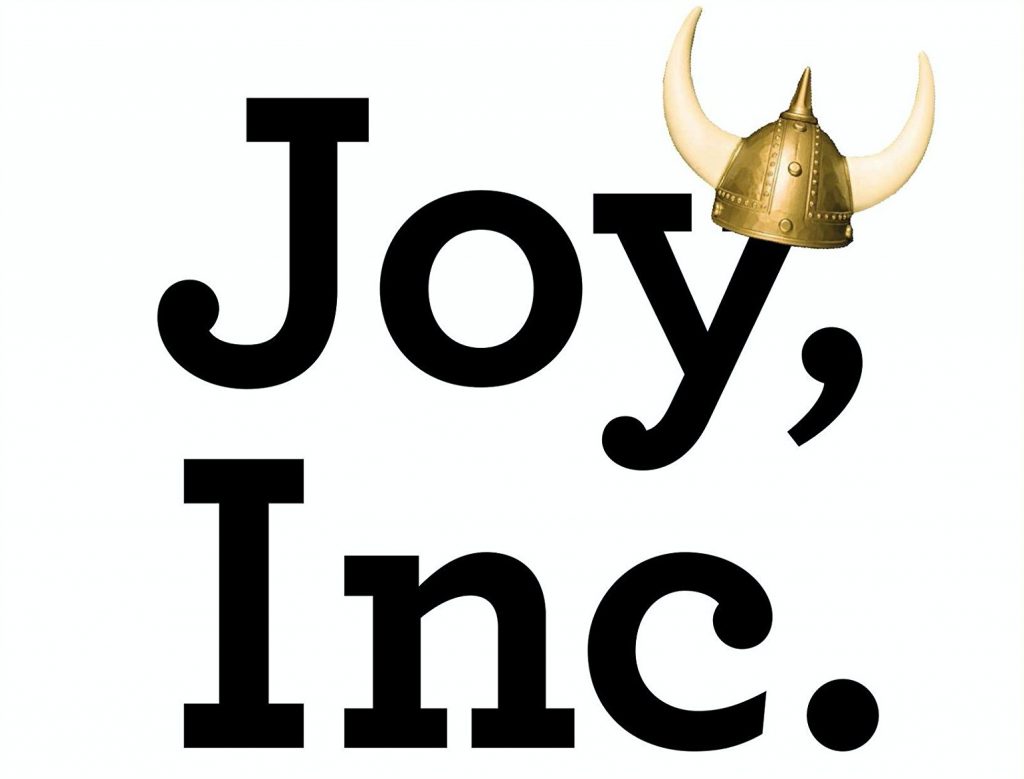
Inside a Human Business. An interview with Richard Sheridan, Co-Founder and Co-CEO of Menlo Innovations
Menlo Innovations is not yet another software development company in Ann Arbor, Michigan. It is unique in many aspects. Face this, every year more than 3.000 people visit this firm to watch how it works. They are inspired by the people, the environment and the way Menlo work. Co-founder, CEO and Chief Storyteller Richard Sheridan writes about this unique place in his bestselling books Joy, Inc.: How We Built a Workplace People Love (2015) and Chief Joy Officer: How Great Leaders Elevate Human Energy and Eliminate Fear (2018).
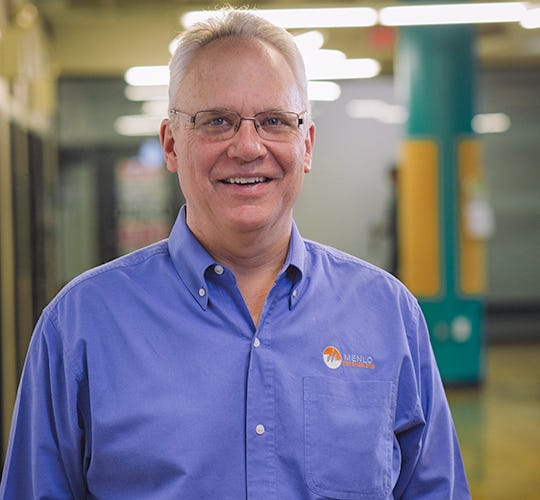
I first met Richard in 2015 as we both participated in the Learning Consortium for the Creative Economy. We shared ideas and stories of how joy, happiness and humanity make huge differences in our world of work.-
In an interview for my new book “Being Human in a Digital Age” (to be published in Germany in 2020) I asked Richard to share his insights about a human business, the Menlo Magic, their way of work, and how to develop an environment where joy and work fit together. In the interview you learn more about
- the driver of Menlo Innovations,
- how striving to end human suffering can motivate you,
- Menlo Magic,
- why trying to scale Menlo’s model can be misleading,
- the importance of a human and creative working space,
- how Menlo communicates with its customers and end users,
- how Menlo cultivates an environment of continuous learning and innovation,
- why structure and discipline are prerequisites for creativity,
- how a human touch can change the overall work atmosphere,
- why and how joy and work fit together.
Menlo’s Driver
Thomas: What’s the driver of Menlo Innovations? What are you pursuing?
Richard: You know, I think, obviously, the word joy always enters into our world here, and, so, what we talk about is that we’ve created an intentionally joyful culture.
To us, all of the words that people might ascribe to us like Agile or lean, that sort of thing, we look at those things through a lens of a simple question: what problem are we trying to solve?
So, rather than pursuing Agile or lean as a goal, we look at it through this lens of problems we’re trying to solve and how this helps end human suffering in the world as it relates to technology.
And so, we look at the tools of Agile and the tools of lean as helping us do that.
Certainly, people who come here who know us well could easily describe us as an Agile organization. Linda Rising called us the most Agile organization in the world. I appreciate Linda’s support when she says those things, but it isn’t the thing we are pursuing.
We are pursuing this idea that we can one day delight the people we intend to serve — and that is our definition of joy — and we’re going to do it by ending human suffering.
Ending human suffering
Thomas: What do you mean by ending human suffering?
Richard: Part of this is born out of my own personal story. I’ve been doing Menlo now with my co-founder for 18 years. 2 years before that, James and I came together to reinvent a public company to something that looks like Menlo today. So, for the last 20 years, I have been living in an environment like Menlo. The 20 years before that, it wasn’t like that at all. I was suffering. I was personally watching projects I was leading miss deadlines, blow budgets, deliver poor quality, work their teams to death, you know, your 24-hour, around the clock, work 7 days a week, people pulling all-nighters, staying all weekend, only to watch projects be cancelled before they actually get delivered. Or if they ever did get delivered, the users would throw up their hands and say, “Well, why doesn’t it work like this? This isn’t what we needed. Why…?” and, of course, the engineering teams would say, “Well, they’re just stupid users. They don’t understand our beautiful designs.”
I watched all of this pain for a good portion of my career, and I thought I don’t want that. I don’t want that for the people who pay for software to be built. That’s one form of suffering. People who don’t know technology, but they need it. And so, they pay a team like mine to build it for them, and, often, executive sponsors of projects get very frustrated with the work of software teams. We have a lot of code words in our world. When we something like, “Well, it’s done but it’s not done done,” and those kinds of things. So, I didn’t want that for them.
I wanted people who were paying for software to be built to feel like they were in control, that they had a voice, that they had a healthy interaction with the technical team that was building it.
So, that was the first form of suffering is for the, what I call, the sponsors of software projects.
The second kind of suffering we really took aim at is for the end users, the people we ultimately intend to serve with the work that we do.
Too often, our industry has learned to call the people we serve stupid users. We thought, no, it doesn’t have to be that way. If we actually take a different approach to what the users’ experience will be, we can delight them. We can have software work the way they need it to work.
Too often, software teams might be tempted to say, “You know, if you learn to think like me, the software will make sense,” and the question is, why would a normal, regular, non-technological human being need to think like the programmers? Why can’t we make the computer and the software that runs on it think like the humans?
We want to end that kind of suffering, that suffering of the people who use software that teams like ours builds every single day.
And then finally we wanted to end the suffering for the people who do the work.
Our industry, coined the term “death march”, 24/7, teams of people burning themselves out, and the trouble with that kind of burnout is, our fundamental view is, tired people make bad software. We don’t want to make bad software so we’re not going to have tired people.
So, those are the three pillars of suffering we wanted to end.
But we didn’t want to characterize it only as suffering. We wanted to characterize it in terms of a more noble goal. And this idea is of returning joy to technology for the people who do the work, for the people who pay for the work, and for people who use the work.
Menlo Magic
Thomas: What is the Menlo Magic? How does it work? And, why does it work every single day?
Richard: I think there’s two fundamental pieces to why Menlo works as well as it does.
Number one, the people who come in our door every day, the people who work here, actually believe in how we approach what we do. This isn’t cow towing to a mantra or a discipline or methodology or process or, you know, a religion, if you will, that I think a lot of times software teams end up in. The team believes in the process we use here.
And then the second part is, and this will sound a little bit funny, the people who work here actually want Menlo to survive to see another day. They don’t want to go back out into the real world. They actually want to work here.
Scaling Menlo’s model
Thomas: Would it be possible to scale your model?
Richard: First of all, we’re about 60 people right now, and a lot of people look at us and say, “Oh, I see it works for 60 but it couldn’t work for 90 or 200 or 2000,” but we have found examples of companies that work a lot like us — … companies, for example, who work at a much larger scale but still quite decentralized, still very purpose-driven.
I remind organizations that even if you’re a large organization, you are typically composed of 50- to 100-person teams, no matter how big the company is, and so if you’re thinking of pursuing some version of what we’ve created here — which I would certainly encourage you to think about that — don’t think you have to change the whole world. You don’t have to change your entire organization. You can just change the part around you, because, in some ways, Menlo is much, much, much, much bigger than what first comes to mind because we are plugging Menlo as a company into some of the largest organizations on the planet. We’ve done work for Ford. We’ve done work for General Motors. We’ve done work for Pfizer. All of these enormous corporations are using our team. They didn’t have to change their corporation to work with us and we didn’t have to change how we worked in order to work with them.
So, in some ways, you’re seeing the example of how a small cohesive team can create a particular culture and serve others who don’t necessarily subscribe to all those same cultural elements you do. And then I think this is scaling and we’ve seen this happen, too.
We have created our own interesting environment. It is interesting enough that people actually want to come see it. We get about 3000 people a year come through our doors from all over the world and they just want to see how we operate. We do about 1 to 3 tours a day here. And, so, now what happens is people come here and visit and they take some piece back with them.
We don’t tell them we found the one true way that, you know, you should work like Menlo or it won’t work at all, but they’ll take something back with them and they’ll start to improve their lives, their world, their work world.
Imagine if you were inside of a large corporation — pick your favourite large corporation — and your team within that company is operating differently, so differently that other people within the corporation are coming to visit you, see how you work, and you share with them what you’ve learned, and they start taking pieces and parts back to their organization to try it out.
I think this is one of the challenges of scaling where people think, “Oh we have to replicate it. It must be identical in every place you go,” and I just don’t think that’s true.
Menlo doesn’t have to be the same even in every client project, and we certainly don’t have to have the same types of customers that we plug Menlo into.
What I don’t want to do is let your readers off the hook here. What I mean by that is they might come and look at Menlo or they read our interview or maybe they read my books and they say, “Oh, Rich and his team, they’re so lucky. I wish I could be them, you know, but I can’t be because our organization is too big, it’s too small, it’s too old, it’s too new, it’s too governmental.” I’m not going to let them off the hook because I have seen so many examples of big corporations that have taken some piece of what they have learned from us and bring it home for their teams and improve their work world. My challenge to your readers is, you can create change within your organization, you just have to choose to do it.
Thomas: So true. It’s also my philosophy. I believe in smaller projects rather than huge corporate programs which can easily become death march projects trying to save the world or the whole organization. Instead I’m proposing to do one project at a time. A project is like a microcosm which the team can control. We can shape it, we can design it the way we like it, and we can change it if we have to. It’s much more complicated on a corporate level with all the politics and bureaucracy. It’s a different story.
The meaning of a human working space
Thomas: How does your working space affect the team productivity? What kind of impact does it have on the atmosphere, the performance, and the results?
Richard: I think for us it’s, as Dickens would say, A Tale of Two Cities.
You know, we are in a former mall. Actually, the space behind me is a former food court. … It is in fact in the basement of a parking structure and there is no sunlight whatsoever. So it’s all electric light that lights the space.
And so, maybe my challenge to your readers is if we can create joy in the windowless basement of a parking structure with concrete floors and so on, you can do it where you are too.
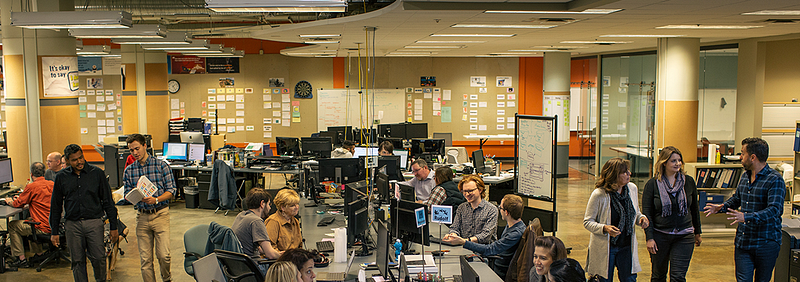
A lot of people ask us, “Oh, you didn’t want sunlight?” No, we wanted sunlight, but we wanted three other things more. We wanted one big open room. We wanted to be in the downtown Ann Arbor area because the physical surroundings we think actually improve our thoughts about work because people can leave the building, go out onto the street, go to restaurants and bars in the local area here. There are little parks nearby, and so on. So, there’s a lot of amenities to being in a downtown area, and we wanted to be able to afford it. And so we lost natural light in that process.
But yet when people walk in our door for the first time, almost universally the first word out of their mouths is, “Wow,” because they can actually feel the human energy of our space. I think that is so important. They can hear laughter, they can hear conversations, they can see people working together.
And suddenly it strikes them, oh my gosh, there are no walls, there are no offices, there are no cubes, there are no doors, and then they begin to question us.
They’re like, “Oh, this is one of those open office environments, isn’t it?” and they say, “Those don’t work, you know. There’s research that proves that these environments don’t work,” and yet they’re confronted with this paradox because they can see it working, and they ask us, “Rich, why does it work for you and it seemingly doesn’t work anywhere else?”
And I say, “well, it’s very simple.
We didn’t create an open office. We created an open culture. Our physical space is a reflection of some of our deepest held cultural beliefs about creating great teams: openness, transparency, collaboration, teamwork, work done together, flexibility and scalability.”
Everything we’ve done here says to the team, make the space work for you. You don’t have to go ask permission. You don’t have to go check in with the space police. You just simply make the space work for you.
So, our space changes in small ways every single day. Every once in a while, the team just get bored with the setup and they tear the whole thing down and put it back together in a completely different configuration. And I will tell you those small changes, and sometimes those big ones, are energizing. You know, we become a product of our physical space after a while. I think it was a Churchill quote that said first we form our spaces and then our spaces form us.
And if we put all these walls and corridors up and doors that close, you can’t move them and then your organization gets stuck in a rut, and communication starts to fall down and, you know, mindsets set in concrete. We want people to always be in this adaptable mindset.
What if we move things around this way? How does that feel and could it change our energy? And I will tell you. I sit out in the room with everybody else. There’s no corner office for me, and every once in a while, they move me. I don’t actually choose where I sit. They put me somewhere. Right now, I’ve been in the same table spot for several months, which is a little bit unusual for me.
So then they’ll move me. There’s usually an actual reason behind the move. They don’t just do it randomly. Then I come in the next morning and my table isn’t where it used to be, and I go to where my table used to be and my mind kind of like, “where did my table go?”, and I have to go find it, and probably for the next several days, I am going back to the old spot before I go to the new spot. And it’s literally bumping my brain, right?
It’s creating what was this passive sort of beta thinking process into more of an alpha mode of just I’m now aware. I’m now very aware of my physical surroundings once again and I can feel it. It’s frustrating because I’m used to going to the same spot but it’s also energizing because I have to think differently. I can’t think the same thoughts I thought the day before because I’m now in a new space. I’m probably surrounded by different people, different interactions, different conversations that I’m overhearing by different people because I’m sitting near different people now.
And that, I think, awakens our humanity when we do those kinds of things.
Customer and user interaction
Thomas: You talk about delighting your customers. Given that the prerequisite for doing so is understanding their true needs, how do you identify the true needs?
Richard: There’s kind of two conversations that go on here and I’m going to differentiate between two groups of people that often get put together.
One is customers. Now, Menlo is a custom software design and development firm. Customers are bringing big bags of cash and some ideas. We form teams around their ideas, and we design and develop software for our customers who are paying us to do that. The customer is the one who pays us to do the work.
But our primary thought process isn’t actually around the customers, even though we have to take care of them of course. Who we want to take care of are people we will never meet, people who won’t pay us for what we do, and people who will never know who we are, and those are the end users of that software. And this is very important.
Most businesses actually have this dichotomy between the people who pay them for what they do and the people who one day use the pieces and parts.
So, there’s often in this world of work, and especially when businesses work with other businesses, there’s this differentiation between customers and users, and we have to take that into consideration when we’re working on our projects.
I want to answer your question in two different ways. A customer, i.e. the people who pay us to often come in our door and they say something — you know, I’ll use it fairly generically — “Hey. We’ve heard great things about you guys. We think you could help us build an app for an iPhone.” We look at them and say, “Well, awesome. What problem are you trying to solve?” and they look at us funny. They say, “Well, the problem is we don’t have an app.” We explain then, “No, an app is a potential solution but no one in the history of mankind ever woke up and first thing on their mind this morning was, ‘You know what I need today more than anything else? I need a new app.’”
So, we try and back them up into what problem they’re trying to solve, and this is a really curious little journey because often the thing they think is the problem isn’t actually the problem, and I can tell you, as an engineer, I can’t wait to start thinking about solutions. It’s the first thing on my mind.
Often what we do is we ask our customers — remember I’m differentiating between customers and users — could we go visit with some of the potential users of this solution?
We had this big logistics firm come to us, and they came to us and they said, “Hey, Menlo. We know you well. We think you could help us build a new CRM system — customer relationship management system.” I can tell you, for the size of this company, that would have been a very big project for us, maybe one of our biggest. Of course, we asked them, “What problem are you trying to solve?” and they’re like, “We need a new CRM system.” We said, “Well, why do you need a new CRM system?” They said, “Well, we’ve grown through acquisition. We’re now a nationwide firm. We used to be regional only. And because of all the acquisitions we’ve done, every separate company we acquired had their own CRM system. We want to create one unified CRM system across the whole organization so that our offices around the nation can all share customer information with one another.”
Now, I would tell you, as an engineer, this made perfect sense to me. But we said, “Could we go visit your sales offices?” and they looked at us funny and said, “Oh, we know that’s what you’d like to do, but we know what the problem is so you don’t need to do that.” “Well, humor us. Can we go to at least two offices?” and they said, “Sure.” So, our anthropologists went out to two offices of this firm. They started observing them work and they started asking them questions about their work. So, they went to these offices and they said, “Hey. We’re going to watch you work. And what your management believes up in the central office is that you guys have trouble sharing information between offices if they need to transfer information,” and the people in the office smiled politely at us and said, “Oh, we would have never share information with another office.” We’re like, “What? You all work for the same company.” They said, “Yeah, we do. But you have to understand our annual bonus is calculated by how much we outperform the other offices. So, if they make us share information with another office, which they might, we’ll miskey something, we’ll type a phone number wrong, we’ll put in an address incorrectly, we’ll mess up their name so that in fact we will give no advantage to the other offices and then we will outperform them and get a bigger bonus.”
The problem they had wasn’t the CRM system yet. It was their compensation system that was broken.
We think humans are rational, logical creatures, but in fact, you know, when we create the wrong incentives, we will create weird behaviours.
We went back to the management team and said, “Don’t do the project right now. Not yet. Fix your compensation system. Fix your culture first and then maybe a unified CRM system.”
Cultivating a learning environment
Thomas: How do you cultivate an environment of continuous learning and innovation?
Richard: I know you’re working on a book around humanity in the workplace. And I think it’s very important for all of us, as leaders, to consider what is it that actually makes us human.
Like, what are the fundamental characteristics of humanity? And I think they revolve around that part of our brain, that prefrontal cortex, where our most human things happen such as creativity, invention, innovation, learning. All of those things are happening in this most human part of our brain.
So, there’s an anti-part to learning. What should we as leaders not do to promote learning? What we have to remind ourselves is the part of our makeup that — actually steals our humanity and therefore our ability to learn — is fostered by fear. Fear releases chemicals into our bloodstream, adrenaline and cortisol. It shuts down this great part of our brain because this part of our brain is such a big oxygen consumer.
So, literally with fear, if we learn to lead with fear, we will shrink our teams back down to reptile brain and no learning will happen whatsoever except pain-based learning, which is important, no question. We can learn something from pain, you know. All of us touched a hot stove at least once in our lives and we remembered never to do that again.
But the kind of learning I think organizations are seeking now is not “don’t touch the hot burner.” It’s how do we outperform our competition, how do we adapt to a changing world, how do we lead in that adaptation. And that’s the part where we need to be the most human.
So, number one, learn to eliminate, as much as humanly possible, fear as a tool in leadership and management.
And the other part is how do we create the environment within which learning can just easily happen? And for us, the physical space is important. It’s not just the open room, it’s the posters on the wall, it’s the bright lights. It’s that feeling, that wow feeling, when people walk in.
And then the other part is how we organize the humans on the team. No one here works in isolation. We work in pairs.
That simple construct, you’re putting people together, letting them work together, giving them permission to collaborate, making it a standard of our workplace means no one is ever working in that fearful isolation of, “It’s all on me. It’s all on my shoulders. It’s what I can get done and done by me alone.” For us, this idea of putting people together creates safety that I don’t have to be complete by myself, I can lean on the person next to me, and I expect to be leaned on by the person next to me and I expect them to allow me to lean on them. That idea of ‘make your partner look good, help the person next to you succeed’, creates a kind of safety here where learning can flourish, creativity can flourish, and human energy can flourish.
Ensuring discipline, performance and delivery
Thomas: Learning is one thing. But, how do you ensure discipline, performance, and delivery?
Richard: There are two fundamental components of how we think here at Menlo.
One is we’re a very high structure environment. So, this isn’t laissez faire, do whatever the heck you want, you get some random idea, go off in a corner and start working on it all by yourself. We have a very, very strong structure here, but a very simple structure. So, everybody knows who they’re paired with for the week. There’s a little display as they walk in the front door and, you know, the first day of the week, and they say, “Oh, I’m paired with Thomas,” right, and then, you know, next week, I come in and, “Oh, I’m paired with Michael this week and Thomas is paired with Richard”.
So, this construct starts to remove a lot of ambiguity and goes towards clarity. This is very important in our world, because ultimately, by the time the work is being worked on, you are in a very unclear environment because there’s invention that has to happen, there’s experimentation that has to happen. But if you know what you’re supposed to be working on, what your goals are, how you will be evaluated for how close you got to what was going on. This is a high-structure environment.
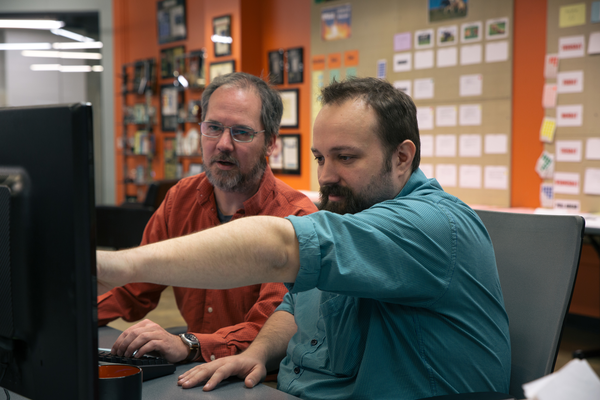
And then the other part that really informs how we think is systems thinking. Systems are at their best when there are short communication and feedback loops.
And that’s what we appreciate so much about the Agile movement. Typically, in our world, we are working on a 5-day iterative cycle. Every 5 days, we check in with our customer through an event we call ‘show and tell’.
So, you know, this isn’t about creating the perfect plan. This isn’t about having the perfect planning process. This is about simply acknowledging we will make mistakes. We are human. The way to keep fear down is make small mistakes quickly.
So, let’s create a system and a structure that allows us to make small mistakes quickly so we can correct them while they’re still small, and if we have open and honest communication, which is critically important in this kind of environment, then we can deal with the things as they come up, and I think, that’s the essence of an Agile enterprise.
Caring for employees
Thomas: I remember you shared a story where you had one of your team members who became a mother, and you wanted her to return but she couldn’t find childcare. You said, “just bring your baby along and we’ll see what happens.” Do you still have this policy in case somebody can’t find childcare for the day? How did it change the environment?
Richard: Yeah. So, yes, that little girl … is now 12 years old and Elsie right now is coming in with George. Elsie is Menlo baby number 24 in the last 12 years.
This has been an awesome experiment for us, and it is delightful. And yes, over the last 12 years, we have continually improved the physical things we put in this space to allow the parents to have an easier time taking care of their child. But I want to say it very clearly, this is not a Menlo daycare. We did not open up a daycare facility. The baby is with the parent all day long or if the parent chooses, and they often do, the baby is also with the team. So, if you bring your child, you may say to Rich, “Hey, do you want to hold little Elsie for a while?” and of course I love holding little children so I might be caught on a tour carrying a baby around, but that’s always the parent’s choice.
We are thinking in terms of humanity in the workplace, if you want to bring humanity into your workplace, bring humanity into your workplace, especially little humans.
I mean, babies have such incredible human energy. They’re like little sponges. They want to hear all the noises and it’s really fun. Usually when they’re here for a couple of months, they start mimicking what they hear. Sometimes, I remember with little Maggie, one of the things that happened was, at a certain point, Maggie started making what we affectionately referred to as dolphin sounds.
She just mimicked the sound. And it would be so loud that the whole team would hear it and they would just laugh. Then suddenly, at one point, Maggie realized she was the source of the laughter, and she just started making the dolphin sounds over and over and over again and the team just kept laughing. It was a wonderful interaction with a baby.
So, I will tell you, it’s a huge thing that we’ve done here, and I’m so delighted for the parents who have been able to make it work.
Joy and work
Thomas: How do joy and work fit together?
Richard: I think this idea of, as you would put it, chasing humanity, bringing our most human self to work, and we use the word joy here which we think is very human in that regard.
I want to emphasize in this is that this is also real work. Joy is a neat thing to pursue and I think we get very close every single day, but we are not happy here every single day. This is hard work, hard work done together.
Our customers often have different expectations for us, so we have to always keep checking in with them about how things are going and how they’re feeling about things and so on. And they’re not always feeling great. Same for us who work here.
As leaders we have to remind us that,
if we really want to keep ourselves on this track towards increasing the humanity of the workplace, we have to recognize that the people who work here are 100% human.
They’re not just human at work but they’re human at home as well. If we start to recognize they have lives outside of work, I think we create a greater opportunity for empathy with others in our team. I can tell you, every family, every person has their stuff, stuff from their previous life, stuff from their upbringing, you know, stuff that happened in the world, stuff they’re worried about, all that kind of stuff.
So, I would just simply encourage your audience to think about one thing. When they have conflict with somebody else in their team regardless of what their current environment is, before they get upset, before they get mad, check in with the other person. Look them in the eye and say, “Are you okay? Is everything going okay in your life?” Now, that person may be willing to share or maybe they’re not. That’s okay. This isn’t about bringing everything to work every day. But a simple human check-in of saying, “Hey, I noticed something wrong today. Are you okay? Is everything going okay in your world?” and if they say it is, but you notice they’re holding something back a little bit, then check in on you. Maybe whatever’s upsetting them is actually coming from you. So, be humble enough to say, “Am I okay? Am I okay with you? Is there anything I’ve done to upset you lately?” Because, in that case, we’ve got a chance to actually have a heart to heart discussion about maybe what’s going on. And, again, not everyone will feel right about that and that’s okay.
Let me share a story with you. Shortly after my first book came out, I was invited to be the keynote speaker at the Scrum Alliance Conference in Berlin. I spoke of joy and I spoke of Menlo and I spoke of the processes we use. I ended the talk with the baby story that we discussed a few minutes ago. After that talk I had male German engineers come up to me in tears, and I would describe tears of a different kind of joy, a joy that was not what they were experiencing today, but a joy of hope that they could experience it someday. And I thought to myself, “If I could get male German engineers to cry, I can get anybody to cry.”
— — — — — — — — — — — — — — –
Note: The interview is part of my new book “Being Human in a Digital Age” which will published in Germany in 2020. If you are interested to learn more about the book, join my Facebook group „Being Human“.
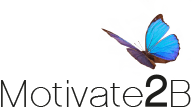
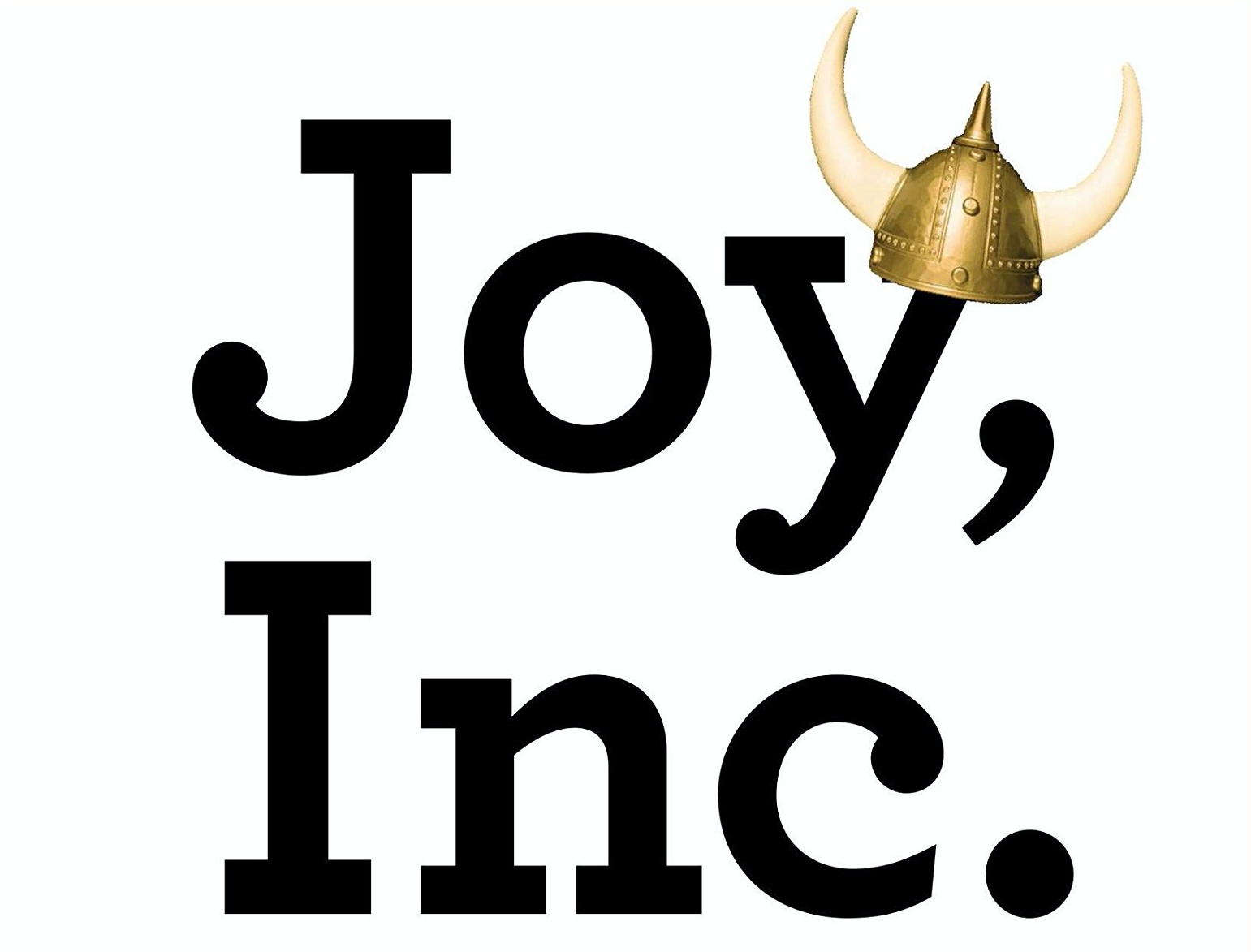
That is very fascinating, You’re an overly professional blogger.
I’ve joined your rss feed and look ahead to searching for more of your great post.
Additionally, I’ve shared your website in my social networks